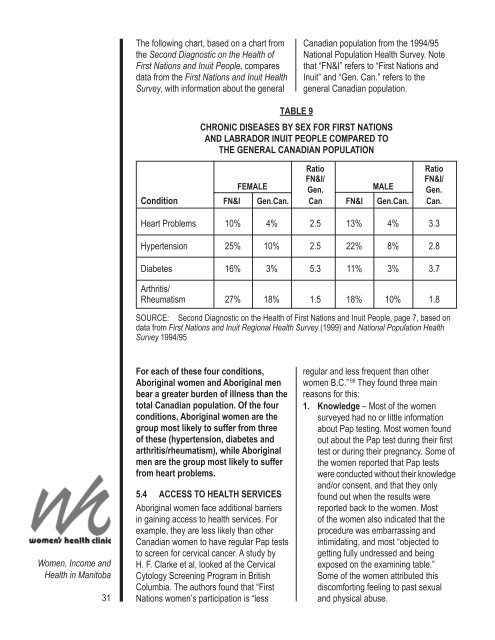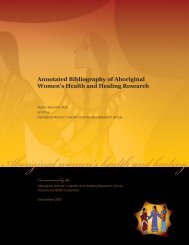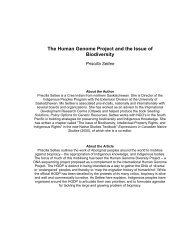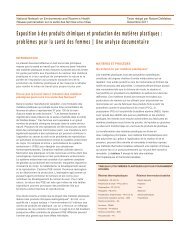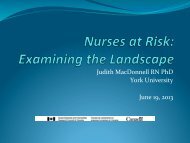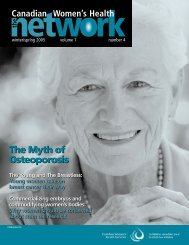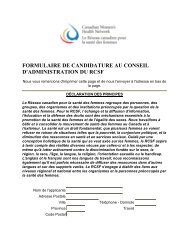here. - Canadian Women's Health Network
here. - Canadian Women's Health Network
here. - Canadian Women's Health Network
- No tags were found...
You also want an ePaper? Increase the reach of your titles
YUMPU automatically turns print PDFs into web optimized ePapers that Google loves.
The following chart, based on a chart fromthe Second Diagnostic on the <strong>Health</strong> ofFirst Nations and Inuit People, comparesdata from the First Nations and Inuit <strong>Health</strong>Survey, with information about the general<strong>Canadian</strong> population from the 1994/95National Population <strong>Health</strong> Survey. Notethat “FN&I” refers to “First Nations andInuit” and “Gen. Can.” refers to thegeneral <strong>Canadian</strong> population.TABLE 9CHRONIC DISEASES BY SEX FOR FIRST NATIONSAND LABRADOR INUIT PEOPLE COMPARED TOTHE GENERAL CANADIAN POPULATIONRatioRatioFN&I/FN&I/FEMALE Gen. MALE Gen.Condition FN&I Gen.Can. Can FN&I Gen.Can. Can.Heart Problems 10% 4% 2.5 13% 4% 3.3Hypertension 25% 10% 2.5 22% 8% 2.8Diabetes 16% 3% 5.3 11% 3% 3.7Arthritis/Rheumatism 27% 18% 1.5 18% 10% 1.8SOURCE: Second Diagnostic on the <strong>Health</strong> of First Nations and Inuit People, page 7, based ondata from First Nations and Inuit Regional <strong>Health</strong> Survey (1999) and National Population <strong>Health</strong>Survey 1994/95Women, Income and<strong>Health</strong> in Manitoba31For each of these four conditions,Aboriginal women and Aboriginal menbear a greater burden of illness than thetotal <strong>Canadian</strong> population. Of the fourconditions, Aboriginal women are thegroup most likely to suffer from threeof these (hypertension, diabetes andarthritis/rheumatism), while Aboriginalmen are the group most likely to sufferfrom heart problems.5.4 ACCESS TO HEALTH SERVICESAboriginal women face additional barriersin gaining access to health services. Forexample, they are less likely than other<strong>Canadian</strong> women to have regular Pap teststo screen for cervical cancer. A study byH. F. Clarke et al, looked at the CervicalCytology Screening Program in BritishColumbia. The authors found that “FirstNations women’s participation is “lessregular and less frequent than otherwomen B.C.” 66 They found three mainreasons for this:1. Knowledge – Most of the womensurveyed had no or little informationabout Pap testing. Most women foundout about the Pap test during their firsttest or during their pregnancy. Some ofthe women reported that Pap testswere conducted without their knowledgeand/or consent, and that they onlyfound out when the results werereported back to the women. Mostof the women also indicated that theprocedure was embarrassing andintimidating, and most “objected togetting fully undressed and beingexposed on the examining table.”Some of the women attributed thisdiscomforting feeling to past sexualand physical abuse.


